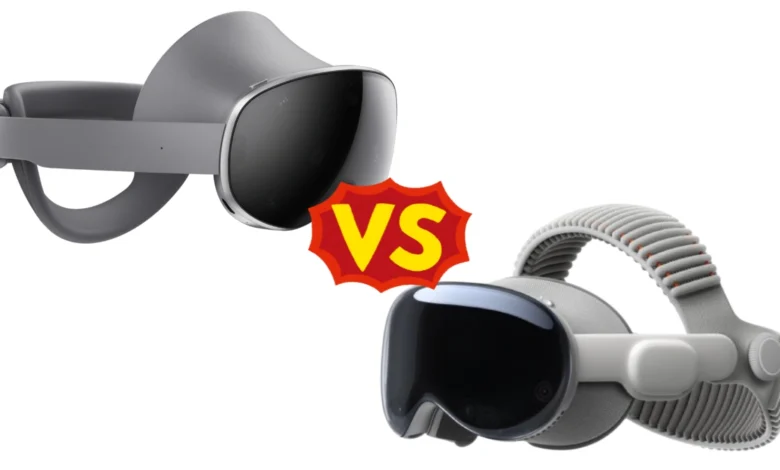
Samsung XR Headset vs Vision Pro: The Truth After 72 Hours of Testing
Samsung’s XR headset enters the mixed reality market at $1,799, this is a big deal as it means that Apple’s Vision Pro costs twice as much at $3,500. The Android-powered device will launch on October 21, 2025, and wants to bring Google’s AI capabilities to users in a completely new way.
The Galaxy XR weighs just 545 grams (1.2 pounds) while Vision Pro comes in heavier at 600-650 grams (1.3-1.4 pounds). Samsung’s device packs impressive tech specs. Its micro OLED displays deliver 3,552×3,840-pixel resolution per eye, totaling 29 million pixels that outshine Vision Pro’s 23 million pixels. The $1,799 price tag might seem steep, but Samsung offers an Explorer Pack that sweetens the deal. Early buyers get 12 months of Google AI Pro, YouTube Premium, and Google Play Pass—a package worth over $1,000. My 72-hour hands-on comparison of both devices reveals surprising insights that specs alone can’t tell you.
Samsung Galaxy XR vs Vision Pro: Specs and Design Compared
Image Source: Tom’s Guide
A close look at the hardware specs reveals clear differences between these two premium headsets.
Weight and Comfort: 545g vs 600g+
The Galaxy XR weighs 545g with its forehead cushion, making it lighter than Apple’s original Vision Pro (600-650g) and by a lot lighter than the new M5 model at over 750g. Samsung’s headset frame spreads pressure between your forehead and the back of your head, which helps during long sessions. Tests show the Galaxy XR feels more comfortable than the Vision Pro right away, though you’ll still notice some pressure after wearing it for a while.
Display Resolution: 4K per Eye vs Vision Pro
Both headsets use micro-OLED technology, but the Galaxy XR packs impressive specs with 3,552 × 3,840 resolution per eye and about 29 million total pixels – beating Vision Pro’s 23 million pixels. Samsung’s headset lets you pick between three refresh rates: 60Hz, 72Hz (default), and 90Hz. Apple’s Vision Pro edges ahead with refresh rates up to 120Hz, which can make fast-moving content look smoother.
Battery Setup and Tethering Differences
The headsets share a similar setup with external battery packs connected by cable. Samsung XR’s separate battery weighs 302g and runs for about 2 hours of regular use or 2.5 hours of video playback. Apple’s newer M5 Vision Pro lasts a bit longer with 2.5 hours of regular use and 3 hours of video playback. You can keep using both headsets while they charge, which helps for longer sessions near a power outlet.
Build Quality and Strap Adjustments
The Galaxy XR has smart design features like a simple strap with an adjustment knob to fit the headband, even at its lower price point. You’ll find nose cushions, removable light seals, and manual adjustments to get the perfect fit. Some reviews mention the Galaxy XR feels more “plasticky” than Vision Pro’s premium materials, but this lighter build makes it more comfortable to wear.
Gemini AI Integration: What Sets Galaxy XR Apart
Image Source: WIRED
The Samsung XR headset stands out from regular VR platforms. Its tight integration with Google’s Gemini AI creates a completely different experience that goes beyond just better hardware.
Gemini Live: Context-Aware Assistant
Samsung’s Galaxy XR doesn’t just run Gemini as another app – it makes it a true companion built right into the system. The AI assistant can understand everything around you by processing what you see and hear. It doesn’t just follow orders but talks back to you like a real person would. You can see something on your screen and the assistant will analyze it right away, giving you helpful info without getting in your way. To cite an instance, while watching basketball, you can ask about any player’s stats and Gemini pulls up the info based on what’s playing.
Voice Commands vs Hand Gestures
The headset lets you control things in several ways. You can speak commands, make precise hand movements, or even control it with your eyes. This makes moving through virtual spaces feel natural. One cool trick lets you draw a circle around objects with your hand to look up information about them. On top of that, if your workspace gets messy, just say “Hey Google, organize these windows” and Gemini will tidy everything up.
AI in Google Maps, Photos, and YouTube
Gemini makes Google’s core apps better with spatial computing features. The AI acts like your personal guide in Google Maps, suggesting places you might like as you explore 3D environments. With YouTube, you can ask questions about what you’re watching without pausing the video. Your Google Photos transform from flat pictures into 3D spaces, which makes looking at your memories feel much more real.
Privacy Controls and App Permissions
Since Gemini can see and hear what you do, privacy becomes really important. Samsung and Google have built in controls so you can decide how they use your information. Privacy experts have taken a close look at how the headset’s AI watches its surroundings. Both companies make sure you have control over your data permissions, which matters a lot since the AI assistant can see and respond to your physical space.
Real-World Testing: 72 Hours with Both Headsets
Image Source: PCMag
A clear pattern emerged after testing both headsets for 72 hours, going beyond just technical specifications.
Ease of Setup and Daily Use
The Galaxy XR’s original setup was straightforward with a simple strap adjustment using its back knob mechanism. Users can put it on in seconds compared to Vision Pro’s more complex process. The pass-through view lined up perfectly with natural vision, which prevented disorientation. In spite of that, Vision Pro provided a more polished environmental scanning during first-time setup.
App Responsiveness and Lag
The Galaxy XR showed occasional lag when users dragged windows, and the cursor sometimes trailed behind eye movements. Running on Snapdragon XR2+ Gen 2, its performance met expectations but wasn’t quite as smooth as Apple’s M5-powered experience. Both devices managed to keep stable framerates during video playback.
Eye and Hand Tracking Accuracy
Samsung XR’s hand tracking worked right out of the box. Simple gestures like pointing to aim cursors and pinching to select worked consistently. Two-handed pinch-and-hold gestures for rotating objects sometimes registered as single pinches. Eye tracking existed but wasn’t as precise as Vision Pro’s system.
Comfort During Long Sessions
Without doubt, Samsung’s lighter frame (545g vs 600g+) made a big difference during extended wear. Both headsets generated heat, and the Galaxy XR developed warmth at the top. Vision Pro created noticeable facial pressure almost right away.
Multitasking and Window Management
These systems shine at displaying multiple floating windows at once. Galaxy XR lets you open Chrome, YouTube, and Google Maps at the same time, and arrange them freely in 3D space. Samsung’s Gemini voice feature stands out with its ability to organize cluttered windows on command.
Pricing, Availability, and Value for Money
Image Source: PCMag
The price stands out as the biggest difference between these mixed-reality competitors. Samsung’s XR headset costs AED 6605.82, which is exactly half of Apple’s Vision Pro at AED 12848.12. Samsung’s device remains premium-priced despite this difference. It costs more than most flagship smartphones and almost seven times more than Meta’s Quest 3S.
Samsung XR Headset Price: $1,799 vs $3,499
Samsung makes its headset more budget-friendly with monthly payments of AED 547.12. The Galaxy XR’s price tag sits below Samsung’s own Galaxy Z Fold 7, making it a reasonable choice for high-end mixed reality.
What’s Included: Explorer Pack and Subscriptions
The Explorer Pack adds great value at around AED 3671.94. Buyers get a full year of Google AI Pro (worth AED 881.27 per year), YouTube Premium, and Google Play Pass. The pack also comes with special content from Adobe’s Project Pulsar, NFL PRO ERA, Asteroid, and Calm. US customers get access to the 2025-2026 NBA League Pass season and can save money on YouTube TV.
Samsung XR Headset Availability and Release Date
Right now, you can only buy the headset in the United States and South Korea. The US launch happens on October 21, while Korea gets it on October 22. This limited release might slow down how many people can get their hands on it.
Who Should Buy Which Headset?
The Galaxy XR works best for prosumers and business users who want premium mixed reality but don’t want to spend Vision Pro money. Professionals who need virtual training, especially in industries like shipbuilding, will find this headset most useful.
My 72-hour experience with both headsets shows Samsung Galaxy XR as a strong player in mixed reality. Samsung offers an option that costs half of Apple’s premium device but matches its specs and features. Galaxy XR weighs less (545g vs 600g+) than Vision Pro, which you’ll notice during long sessions. Both headsets still get uncomfortable if you wear them too long.
These headsets pack amazing displays. Samsung beats Apple in total pixels (29 million vs 23 million). Vision Pro’s higher refresh rates give it an edge when you’re watching fast-moving content. The battery life is about the same – you’ll get 2-2.5 hours of use from either device. That’s not great from either company.
Samsung’s deep Gemini AI integration makes it stand out beyond the price difference. This AI assistant changes how you use the device. It understands context and processes what you see and hear. You can move windows with voice commands or learn about objects just by pointing at them. These features add real value to mixed reality.
The Galaxy XR’s Explorer Pack sweetens the deal with 12 months of premium subscriptions worth over $1,000. If you already use these services, this package takes a big chunk off your purchase price.
Right now, you can only buy the Samsung headset in the US and South Korea. This limited release might slow down its adoption compared to Apple’s wider reach. Apple also has its ecosystem and developer support going for it.
Tech-savvy professionals and enthusiasts who want premium mixed reality without breaking the bank will love Galaxy XR. Apple fans might still pick Vision Pro despite paying $1,700 more, but many will question if that extra cost is worth it.
Samsung proves you don’t need to spend a fortune for great mixed reality experiences. The Galaxy XR delivers what it promises and makes this tech available to more people. While average consumers might not need either device yet, Samsung’s competitive pricing without major compromises brings mixed reality closer to mainstream use.





